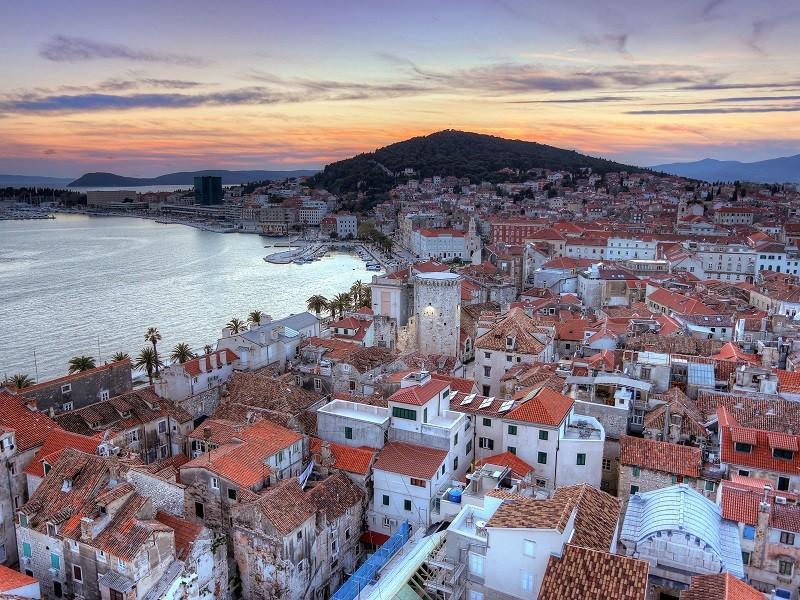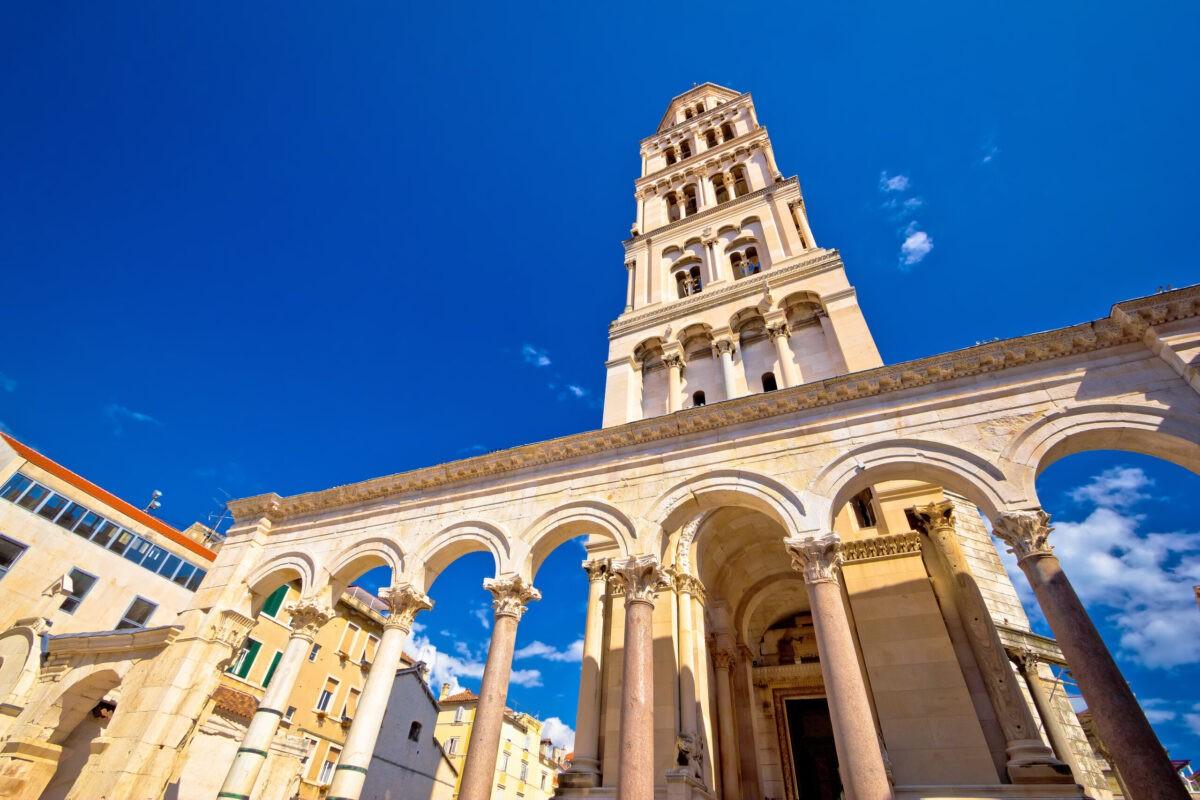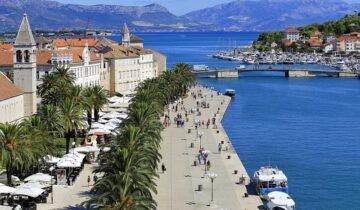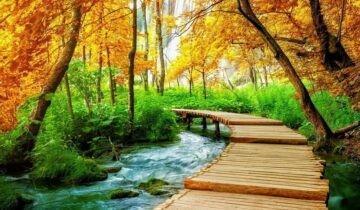A few general facts about Split Croatia – the town is the second-largest city in the country and the largest city in the Dalmatia region. The city was originally built around the Diocletian’s Palace (a fortress-like palace built for the retired Roman emperor Diocletian), where the locals sought refuge many centuries ago. However, despite its initial appearance, the city is not a small tourist town. It extends over a large area, well beyond the ancient city center. Modern Split is a city with 180 000 inhabitants. It represents the economic hub of the Eastern Adriatic shoreline (an unofficial “capital” of Dalmatia).
General facts about Split Croatia

In general, winter in Split is mild, with an average temperature above 0°C. Despite the popular story that the city has snowfall once every 30 years, there is actually at least one snowy day during every winter (usually in January or at the beginning of February). If you happen to be in Split on a day with significant snowfall, expect serious traffic difficulties.
Almost everything worth seeing during a Split walking tour is concentrated in the old town behind the seafront Riva, built around various remains and conversions of Diocletian’s Palace itself, as well as its medieval additional buildings, situated on the Western side of the palace. You can take a walk through this area in approximately ten minutes, although it would take you a lifetime to explore all its nooks and crannies. On both sides, the old town fades into low-rise suburbs of stone houses, jammed around narrow alleys – Veli Varos, on the Western side of the old town, and Manus, on the Eastern. They are very well preserved, and although there are no highlights, they’re worth a brief walk.
On the western side of the city center, the wooded Marjan peninsula offers fine views over the coast and islands from its heights. The best beaches in Split are on the Northern side of the Marjan or the Eastern side of a ferry dock at the Bacvice.
History of Split city

After his illness in 303 C.E, Diocletian announced that he would retire as soon as his Palace, scheduled for completion in 305 C.E, was ready. The Palace was built as a massive structure, much like a Roman military fortress. It faces the sea on its Southern side, with walls 170 to 200 meters (570 to 700 feet) long, and 15 to 20 meters (50 to 70 feet) high, enclosing an area of 38,000 m² (9½ acres). The palace water supply was substantial, fed by an aqueduct from Jadro spring, which supplies the city to this day. The palace and the city of Spalatum, which formed its surroundings, were at times inhabited by a population as large as 8,000 to 10,000 people.
Under Venetian rule, Split was a part of the Venetian Republic. The city lost all of its autonomy. Venetians introduced the Italian language and Western Latin culture to the Split. The city was an important part of Venetia as a trading post for Southeast Europe and the city itself also grow culturally. Famous citizen Marko Marulic was born here and his poem Judith was written both in Latin and Croatian language. In those times, only aristocracy (mostly Italian) was literate and educated, and the rest of the citizens (mostly Croatians, who were the majority) were illiterate.
As Turks gain power, Split became endangered. Most of Dalmatia (as well as large portions of Eastern, Southern and Central Europe) was conquered by Turks. In wars between Turks and Venetians, from 1645. to 1669, the city itself was besieged several times by Turks. But, defenders from joined Croatian–Italian forces defended the city. Venetians helped during the building of Fort Gripe for the city’s defense. Fort Gripe is well preserved to this day and it is used as a tourist attraction, as one of many city museums, concerts and other events arenas.
In 1806. Split fell under Napoleon’s rule and became part of the so-called Illyrian Provinces, after Napoleon’s victory against Venetia and Austrian Empire. That period was relatively short (1806. -1813.), but Split underwent huge rebuilding and reorganizations in that short time. Today, there is a Marmont Street in the old part of the city. After Napoleon’s defeat, Split fell under the rule of the Austrian Empire and it remained so until the end of WW I in 1918. Split continued to develop economically and culturally under Habsburg Monarchy, although Dalmatia was one of the least developed provinces of the empire. After WW I and the dissolution of the Austro-Hungarian Empire, the city was united with the rest of Croatia and the newly formed state joined the Kingdom of Serbs, Croats and Slovenes, later renamed into the Kingdom of Yugoslavia. As cities, Rijeka and Zadar were annexed by Italy as part of the WW I agreement between Entente powers, Split became the most important coastal city in the new Kingdom of Yugoslavia. As WW II spread over Croatia and Yugoslavia, Split and most of Adriatic Croatia were annexed by Fascist Italy. Croatian population of the Split joined anti-fascist resistance. About one-third of the population was involved in active resistance against fascists. Split football club “Hajduk” was the official football team in the Partisan movement. In a period when the city was occupied by Axis powers, Allied forces bombed the city, killing hundreds of civilians. On October 26th, 1944. Split was finally liberated by anti-fascist communist guerrilla and the city became part of the Socialist Republic of Croatia, one of the Republics of the Socialist Federal Republic of Yugoslavia.
Sites in Split town
Diocletian’s Palace (UNESCO’s World Heritage Site) – The historic center of Split is built around the remains of this Roman palace. The palace has well-preserved main street cardo and decumanus. The Roman palace is enriched with some Gothic and Renaissance buildings, which make a perfect match. The Palace has four monumental gates: Porta Aurea (Zlatna vrata, Golden gate), Porta Argenta (Srebrna vrata, Silver gate), Porta Ferrea (Željezna vrata, Iron gate) and Porta Aenea (Mjedena vrata. Bronze gate). It is one of the best-preserved Roman palaces in the world and the oldest palace in Split, Croatia.
Cathedral of St. Dominus – Originally, it was built around 305 A.D. as a mausoleum for the Roman emperor Diocletian (the oldest cathedral in the world). The Cathedral is a very beautiful mixture of Roman temples and Catholic churches. It also has a beautiful bell tower, that offers a great panoramic view of Split Croatia, nearby islands and Marjan hill.
Peristil square – Split’s main square, the former entry hall into the Diocletian’s Palace. It is derived from a Roman architectural term called “a peristyle”, an open colonnade surrounding a court. The spacious central courtyard is flanked by marble columns, topped with Corinthian capitals and richly ornamented cornices, which are linked by arches. There are six columns on the both Eastern and Western sides, and four more at the Southern end, which mark the monumental entrance to the Vestibule. Most of the structure is made of white stone from the nearby island Brac; however, the columns are made of Italian marble and Egyptian syenite marble.
Temple of Jupiter – The Temple of Jupiter is located on the Western side of the peristil, at the end of a narrow passageway called St. John’s end, accessible between the Skocibucic-Lukaris and the Grisogono-Cipci Palace. Originally, there were three temples to the right of the peristil – Kibel, Venus and Jupiter. However, only the latter was preserved till today. The Temple of Jupiter was built around the III c, about the same time as the palace itself. Jupiter was the name of Diocletian’s father, as well as the highest Roman god – god of the sky and thunder. This god was highly worshiped during the Imperial era until the Roman Empire came under Christian rule. Emperor Diocletian believed he was Jupiter’s reincarnation and thus positioned this temple directly adjacent to his mausoleum, instead of the Cathedral of St. Domnius.
Galerija Mestrovic – It is an art museum, dedicated to the work of the XX century sculptor, Ivan Mestrovic. The gallery preserves and presents to the public the most significant works of Mestrovic. The gallery itself represents an art monument. Works of sculpture, drawings, design, furniture, and architecture are on constant display. Collection includes original plaster models of the artist, as well as finished works in bronze, marble, and wood. The gallery building and grounds were based on Mestrovic’s original plans and included living and working areas, as well as exhibition spaces.
Archaeological Museum – Founded in 1820, the Archaeological Museum in Split is the oldest Croatian museum. It has a large collection of archaeological objects from prehistoric times, from the period of the Greek colonization of the Adriatic and from the Roman, Early Christian and Early Medieval Ages. Most monuments come from the region of Central Dalmatia, especially from Salona (Solin). The following collections are very important: stone epitaphs from Salona (about 6.000 of them), Greek Hellenistic ceramics, Roman glass, clay lamps, objects made of bone, metal and gems. The Museum has a large collection of Antique and Medieval coins. The Museum also has a large library with about 30.000 books on archeology and history, as well as on Dalmatia (books and journals about Dalmatia’s history).
Split city Attractions
Poljud stadium – Poljud stadium, better known as “Poljudska Ljepotica” (“Poljud Beauty”) is the second-largest stadium in Croatia with a capacity of 36,000 people. The stadium was originally constructed by the Yugoslavian government as part of the facilities for 1979. Mediterranean Games. It was officially opened by Josip Broz Tito, who was a great fan of the team. The team played their home games in Poljud HNK Hajduk Split. By far, the most important and revered sports team in Dalmatia, dedicated fans around the world have followed Hajduk throughout the team’s history. There are numerous anecdotes that Hajduk never played without at least some of their loyal fans in the stands, the Torcida. It is the oldest supporters group in Europe. If you plan to go to some match, avoid the Northern part, which is the cheapest one because that part is reserved for Torcida.
Getski vrtal – is the smallest park in Split Croatia, situated in the Diocletian’s palace (THE ONLY GREEN AREA INSIDE THE CITY WALLS), on Dominisova Street (Marko Antonio De Dominis Street). In the park, there are beautiful traditional Dalmatian “tiramolas” (that is a way how the locals dry their clothes). During summer, they are full of clothes drying in the sunshine. You will find pictures from the Getski vrtal in every Split guidebook. It is the location of a 500-year-old stone house, that was destroyed during World War II. On the facade facing towards Getski vrtal, you can see two heads made of stones. One belongs to a sphinx and it has a Christian cross on its forehead and the second one is a head of Middle Age thief. Getski (from ghetto) vrtal (garden) is made and maintained by the locals, who live in nearby houses.
Marjan – a hill situated on the West of the Split. Marjan is an oasis for many people, who look for natural stress relief. It is a great place for long walks, jogging, and bike rides. Marjan’s peak, Telegrin is 174 m high and provides a wonderful panoramic view of Split Croatia. Its Southern cliffs are popular for alpine climbers. St. Nicholas Church is situated on the Eastern side of Marjan, and along the Southern rim is the beautiful church of St. Jerome and “Gospa od Betlema” Church (“Madonna of Bethlehem”). House building is strictly forbidden for the preservation of Marjan – the lungs of Split.
Bacvice Beach – the main city center visitor-magnet is Bacvice beach, situated just a few minutes walk to the East from the ferry terminal. This simple sand and shingle beach can’t compare with the beaches farther south, but it remains a popular – and crowded – a destination for locals of all ages. Bacvice is also the spiritual home of “picigin”, a game played only in and around Split. It is something like the net-less version of volleyball in the sea, involving a lot of acrobatic hopping around as players try to prevent a small ball from falling into the water. Just behind the beach is a chic modern three-tier pavilion, some kind of mixture between an Art Deco seaside building and a high-tech metal tent. With several cafés and a couple of swanky eating places inside, it’s a popular venue for a night drinking and feasting throughout the year.
Events in Split Croatia




Split Travel info
By plane – The nearest international and local airport is Split. Split’s airport is approximately 25 km to the Northwest of the town between Kastela and Trogir. Croatia Airlines buses (ticket price is 30 kn one way or 40 kn daily ticket in both ways) connect the city with scheduled flights, dropping passengers on the waterfront Riva, near the Croatia Airlines office; alternatively, the #37 Trogir-Split bus (ticket price is 13.50kn) goes from the airport to the suburban bus station – “Domovinskog rata”, twenty minutes to the North of the city center. A taxi from the airport costs between 200 kn and 300 kn.
By train – Croatia is directly connected to Slovenia, Bosnia and Herzegovina, Hungary, Italy, Austria, Switzerland, Germany, Serbia and Montenegro and with almost every other European country. Regular lines from numerous European cities lead to Split via Zagreb. The train station is five minutes walk away to the Southeast of the city center on the main harbor front road, Obala kneza Domagoja. All the ferry and hydrofoil berths are situated on the same street. There are two daily trains to Zagreb, that stop at Knin and Karlovac on the way (2 per day, 6.5 hours; 1 direct night train, 9 hours); in Zagreb, you can transfer to Ljubljana (4 per day, 9 hours total).
By ferry/boat – Split is Dalmatian coast Jadrolinija main terminal, with regular local ferries rides to the islands of Brac, Vis, Lastovo, Hvar and Korcula; it’s also a major stop in the summer coastal ferry service, which connects Split with Rijeka, Rab, Zadar and Dubrovnik. In summer, the coastal ferry goes to Bari, Italy (1-2 weekly) and Igoumenitsa, Greece (1 weekly), while from June to September there are almost every day ferry rides to Ancona, Italy. For the main coastal ferry, pre-booking is recommended.
By bus – All mentioned routes are provided by multiple companies, that charge slightly differently. Always ask about the fastest option in order to save time. It’s smart to arrive about 30 minutes before departure and buy tickets (better yet, during peak season, it is recommended to buy them earlier in the day). Ask English-speaking staff at Split’s bus station for handy little schedules of popular journeys.
By car – Split is well connected with the rest of Croatia by recently built highways and you can reach it easily and fast once you reach the highway. To come from Zagreb to Split (by A-1 super expressway) you will need to drive approximately 380 km for 3h and pay the toll of 20 to 25 euro. There could be traffic delays during the summer season on the Croatian border. Laws regulating traffic in Croatia are similar to those in the majority of European countries. You can also reach Split by driving on Adriatic Coastal Road free of charge, but you will drive slowly and it could take you about 5 hours to reach Split Croatia.





 No products in the cart.
No products in the cart.